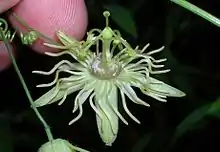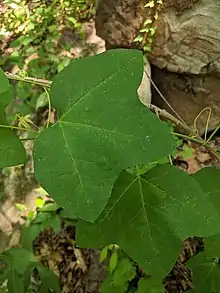Passiflora lutea
Passiflora lutea, the yellow passionflower, is a flowering plant in the family Passifloraceae, native North America, in the eastern and south-central parts of the United States from Pennsylvania west to Kansas, and south to Florida and Texas. It is the northernmost species of Passiflora,[1] occurring slightly further north than P. incarnata,[2] and tolerant of winter temperatures down to −15 °C, and even −30 °C for short periods.
| Passiflora lutea | |
|---|---|
 | |
| Flower | |
| Scientific classification | |
| Kingdom: | Plantae |
| Clade: | Tracheophytes |
| Clade: | Angiosperms |
| Clade: | Eudicots |
| Clade: | Rosids |
| Order: | Malpighiales |
| Family: | Passifloraceae |
| Genus: | Passiflora |
| Species: | P. lutea |
| Binomial name | |
| Passiflora lutea | |
It is a perennial herbaceous climbing or trailing vine that can reach 3–5 m in length. The leaves are trilobed, 3–7 cm long and 3–15 cm broad, with a 5 cm petiole; in the north of its range, it is deciduous. The common name as well as the scientific name refers to the small, 1-1.5 cm diameter chartreuse (yellow-green) or off-white flowers it produces in summer. The flowers are followed by small black berries that contain seeds that are brown and bumpy. P. lutea grows in bright shade to sunny places with moist, rich soil. Very similar to Passiflora suberosa.
Yellow passionflower is often good for butterfly gardens, as it is a host for Gulf fritillaries, julia butterflies (Dryas julia), and zebra longwings (Heliconius charitonius). It is also the only pollen source used by an unusual specialist bee, Anthemurgus passiflorae, which is the sole member of its genus; this rare bee is unusual in that despite its obligate relationship with the plant (oligolecty), it rarely pollinates it.[3]
References
- "Plants Profile for Passiflora lutea (yellow passionflower)". plants.usda.gov. Retrieved 2020-11-28.
- "Plants Profile for Passiflora incarnata (purple passionflower)". plants.usda.gov. Retrieved 2020-11-28.
- Neff, John L.; Rozen, Jerome G. (1995). "Foraging and nesting biology of the bee Anthemurgus passiflorae (Hymenoptera, Apoidea), descriptions of its immature stages, and observations on its floral host (Passifloraceae). American Museum novitates ; no. 3138". Cite journal requires
|journal=(help) - www.naturalheritage.state.pa.us http://www.naturalheritage.state.pa.us/factsheet.aspx?=14261. Retrieved 2020-11-28. Missing or empty
|title=(help)
- This article incorporates text translated from the Dutch Wikipedia page on the species
| Wikimedia Commons has media related to Passiflora lutea. |
